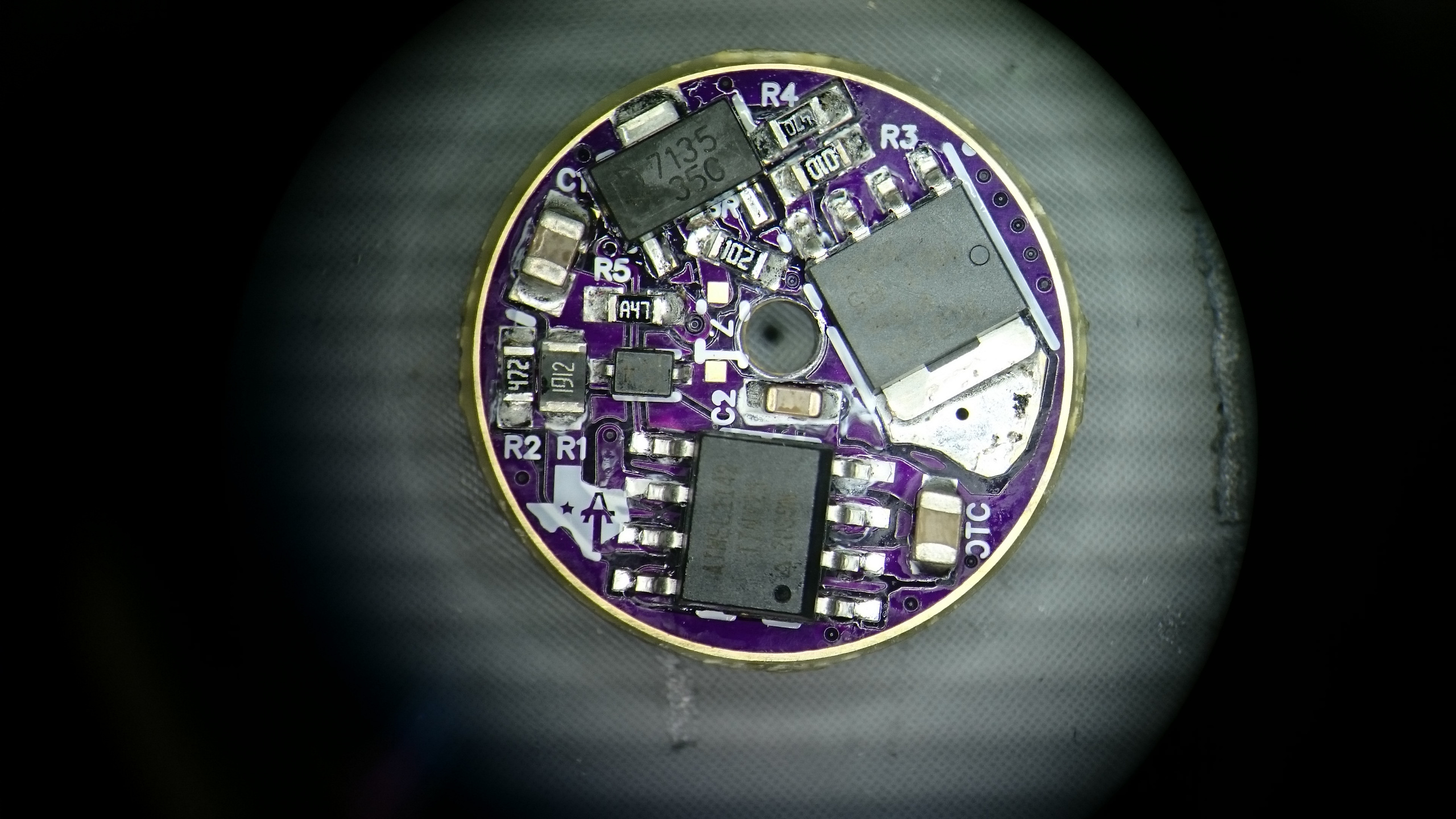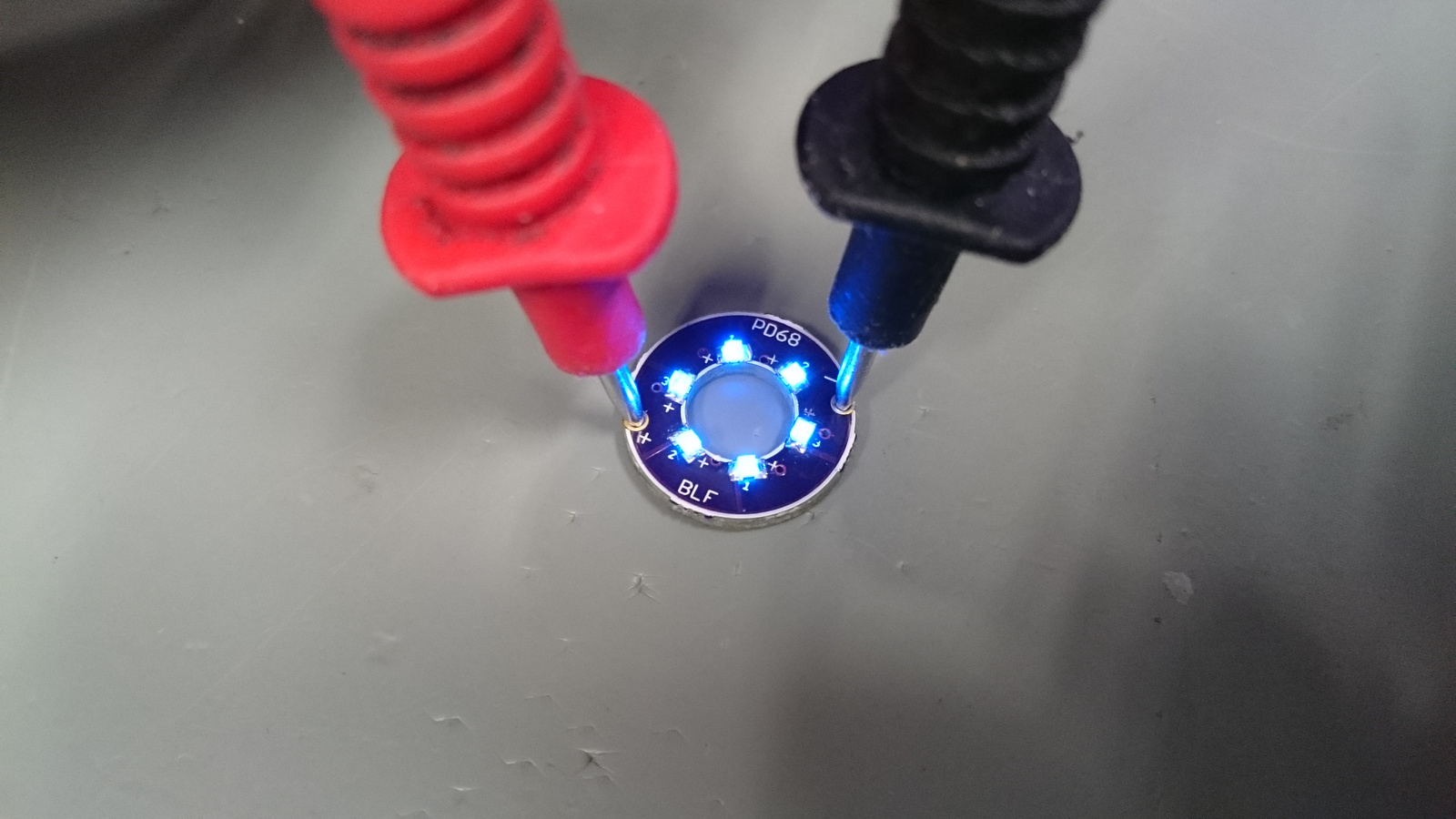Even cheap chinese borosilicate glass will still have a transmittance of 95%+
Which is more than most good quality reflectors.
Today I reflowed an XP-L2 on to KD DTP copper board.

Assembled a Texas Avenger 17mm driver.


And premade a PD68 lighted tailcap board.

Now just waiting for Convoy C8 host to arrive and put all this into that with AR coated glass and OP reflector.
Showing off your picturing skills, Zozz? They are very nice! :+1:
Just my phone and the microscope at work at the top 3 pics ![]()
BTW thank you!
Nice work on the retainer. How was that accomplished?
I had a conversation via PM with member k-wong, about the ‘fix’ that DEL suggested for the BLF X5/X6 drive and that I have done several times succesfully, that should get rid of the high voltage spikes to the MCU and get rid of the drop-to-moon that occurs spontaniously when entering turbo in a high current triple build.
I described the fix here above in this thread but k-wong was still scratching his head over how it is done and suggested making a video about it.
Well, here is an attempt. I hope it clarifies the procedure.
Of course when doing a video, disaster strikes, you can see C1 unintendedly coming loose together with the plus-wire and then me launching C1 at 1.11 minutes, and I never found it back, so at 1.53 there is a cut in the video (very subtle ![]() ), so that I could search for a new C1 in my stash of parts, don’t know for sure what value the stock C1 was, but now it is 4.7 microFarad.
), so that I could search for a new C1 in my stash of parts, don’t know for sure what value the stock C1 was, but now it is 4.7 microFarad.
After the solder job I checked the driver and it seems to work fine.
I used a sanding drum on a flex shaft dremel and finished with a fine rattail file. I was not sure it would go, but it did!
I had a conversation via PM with member k-wong, about the ‘fix’ that DEL suggested for the BLF X5/X6 drive and that I have done several times succesfully, that should get rid of the high voltage spikes to the MCU and get rid of the drop-to-moon that occurs spontaniously when entering turbo in a high current triple build.
I described the fix here above in this thread but k-wong was still scratching his head over how it is done and suggested making a video about it.
Well, here is an attempt. I hope it clarifies the procedure.
Of course when doing a video, disaster strikes, you can see C1 unintendedly coming loose together with the plus-wire and then me launching C1 at 1.11 minutes, and I never found it back, so at 1.53 there is a cut in the video (very subtle
), so that I could search for a new C1 in my stash of parts, don’t know for sure what value the stock C1 was, but now it is 4.7 microFarad.
After the solder job I checked the driver and it seems to work fine.
Yes!! Thanks Jos (and Del), I was ready to buy a bunch of A6 drivers and then I saw your video pop up… I was only kidding when I suggested the tutorial but I’m thankful you did it! Can you provide a link to where I can find the correct 5 ohm resistor to use?
yeah, i admit i love jozz’s pics too…that multiple focus algorithm, whatever… it works pretty sweet…
yeah, i admit i love jozz’s pics too…that multiple focus algorithm, whatever… it works pretty sweet…
The multiple focus thing is awesome, I would love to do that but it was not me, my pictures are made with a cell phone, the video above with an extra lens taped against the camera lens.
I have seen clemence making great emitter pictures with the multiple focus technique.
ha ha…. “budget” works again, lol… love it…
A few months ago I swapped an XML2 (I forgot which bin) in the 5000k tint into an Xtar wk42. Today I quickly scrapped up an optic in there for a flood beam as this light serves solely as my middle of the night EDC for bathroom trips (it was kinda annoying as I had to trim the optic by 2~3mm)
Alas, after a few months 5000k still just feels too cold. I’ll eventually ended up swapping for something warmer (hmm, perhaps I’ll try one of those Nichia 319A)

I put together some spare parts, a Convoy S2+ triple with FET+1 tiny25 driver, and gave it a new clicky-switch ramping UI I call Crescendo.
http://bazaar.launchpad.net/~toykeeper/flashlight-firmware/sandbox/files/head:/ToyKeeper/crescendo/
It’s not as nice as Narsil, but I think it’s pretty good for a clicky-switch light. From off it starts at moon and then ramps up; just tap any time to stop it. From there, tap once to ramp up, tap twice to ramp down, tap three times for a momentary (ish) turbo (tap again to exit turbo), or tap four times for battcheck (and other blinkies). Long-press to reset back to the beginning. Both moon and turbo are accessible from off, or let it ramp to reach any other level fairly quickly.
Also works on tiny13 (nanjg driver, even), but will need some things reduced to fit, like fewer blinkies or a lower-resolution ramp. And there’s an option for memory, but I prefer it without.
It’s not very fancy, but I think that’s okay. Instead of a whole menu of options like bistro, it aims for simplicity.
I figured out the Convoy BD06 driver that is a simple 105C driver just it has a charging circuit on the board which is working separately from the driver part.
… According to this today or tomorrow I will try to flash it with Biscotti FW and I think it will work both driver and charging after all.
I’d love to hear how that goes. I’m thinking of trying to get Convoy to use Biscotti on those by default, or possibly use Crescendo because the BD line has a side clicky switch. This would give those lights a ramping UI, which works well on a side switch.
I changed the MCU and it works with the other one. Added two 7135s and now it’s 3,5A on high. The blinking speed is normal but to change modes I need to be really fast. How can I modify something to have enough time for mode change? Bigger or smaller C1 capacitor, or I need to do something with the firmware?
The timing on that is entirely determined by the hardware. If I understand correctly, you can probably slow it down by using higher-value resistors on the voltage divider. They should still divide to the same value, but let less current through. I think this makes the MCU’s tiny onboard capacitor last longer so the SRAM decays slower, and then you can take more time to do a fast-press.
To reply myself and to collect the whole BD06 FW changing info together. I find the solution for fast button presses. Changed the 1uF C1 capacitor to 2,2uF and it is much better now.
… or you could do that. Probably a better idea. ![]()
All those vias are so I can perform some acupuncture to flash the MCU. No need to remove the driver from the light:
This needs to be a much more common driver feature. It makes reflashing easier and opens up the option to use drivers with a smaller form-factor, more pins, or a denser layout.
I could have used the 85 MU as it has a smaller package than the “regular” size, but went with the 84A MU as at has more IO pins. I am however abandoning the 84A and shifting my attention to the 841.
I could have used the 85 MU as it has a smaller package than the “regular” size, but went with the 84A MU as at has more IO pins. I am however abandoning the 84A and shifting my attention to the 841.
Yeah, the number of pins quickly becomes a bottleneck on tiny85… and the 84A is often hard to fit. I hadn’t heard about the 841 until just now though. It looks like it has some pretty significant differences from the 84A; which differences have you found relevant?
Thanks for all the hard work TK. :+1:
I hadn’t heard about the 841 until just now though. It looks like it has some pretty significant differences from the 84A; which differences have you found relevant?
Power consumption, mainly for the OTC less off time functionality (referred to as OTSM). I didn’t know about the 841 until recently either, I stumbled on it when searching on 84A power saving techniques. It’s newer, has other improvements and the same pin config as the 84A, so I see no reason to stick with the 84A.
Ah, that makes sense. Newer chips are usually much more power-efficient. Given a driver with flashing vias, I’d love to play with a tiny841. Not sure what I’d do with all that space though, since the last thing I made barely comes to 1300 bytes. ![]()
I haven’t had a chance to try OTSM yet, but it sounds cool. Instead, the SRAM decay method has been working pretty well for long/short press detection, as long as I’m careful to check for partially-decayed data, and as long as one doesn’t mind rather short short-presses.

